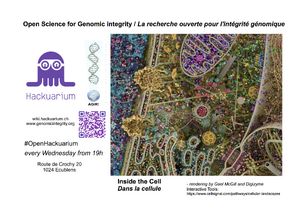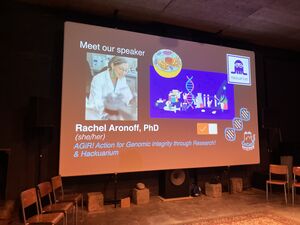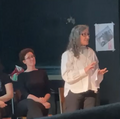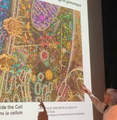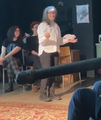Genomic integrity
An explanation of what is really meant by 'dynamic genomic integrity' was attempted in January 2024, for the improvisation group Catalyst.
This is what was shown during a 5 min section of the show...
This is what was supposed to be said (in English for this audience):
Good evening!
It’s already about 7 years since I became president of the public service community lab in Ecublens, Hackuarium, and AGiR! has already celebrated its first decade of existence, but ideas around a concept of ‘dynamic genomic integrity’ were developed since at least 2009, more than 15 years ago, when we needed to find some positive way to talk about damage, genotoxicity and crosslinking of molecular genetic cell components. This became a main theme of my work, aiming particularly to make people aware of common risks to health, especially those we can choose. (flyer printed and QR code for AGiR! project in Hackuarium...)
A simple way to understand what I mean by ‘dynamic genomic integrity’ is what I hope this image will help convey.
It’s meant to depict the many molecules inside of a cell, like one of ours. First, let’s make sure everyone is on the same page and unpack two words, molecule and cell. A molecule is any combination of atoms making a substance, like caffeine or DNA. What is important is that molecules make chemical shapes in 3D, or ‘structures,’ which determine with what they can interact. A cell is the building block of all life. We have skin cells muscle cells, brain cells (and viruses hijack cells). We are all made of cells, which get genetic material from our parents, and differences in gene expression, making different products from the same DNA, by turning some genes off and others on, specifies different cell types. In addition, there are quality control steps, preventing problems from mistakes… In fact, I cloned a conserved gene in such a RNA quality control pathway, implicated in several human diseases.
We can think about the cells in our body as members of the same team. For instance, in volleyball, you often have 2 people playing each position, so the pass, set and spike all come together for a good game.
The activity of molecules that make up cells, allow all the ‘team players’ to fulfill their necessary functions.
These renderings of high-resolution structure data models are shown for just a part of the cell, here. Some of the molecules shown are for information transfer, some are structural, like a skeleton in the cell, and some are pathways for different factors to move along… Mitochondria for energy and vesicles for transport are also shown. You even can go into the interactive site (link below) to explore pathways further (it’s cool!)
On the left side of the image is just an edge of the region with most of the genetic information, the nucleus.
To the right is where this information gets transformed into functional units that do things– like myosin proteins for muscle, or collagen for skin.
The important thing to realise is that the actual density of all these components in the cell is really much higher than what is shown. And, of course, there is liquid and motion in real cells. ...
How can those molecules all manage to do what they need to do in the cell?
With such a crowded landscape, each molecule has to fit in with the others. They all have jobs to do, and need to be free to move, and interact. That’s dynamic genomic integrity, the molecular dance, leading to the choreography of life…
If things get stuck together or broken or pathways are blocked, the cell can start to do the wrong thing, sometimes affecting health.
If a dancer twists an ankle or knocks over their partners, the dance will not be so successful.
But let’s step back a bit, what is so important about understanding free movement of molecules in cells? It’s because our choices can make a difference for more healthy ageing! (one page flyer – easy risks to avoid)
If dynamic genomic integrity is disrupted, for instance from UV damage or cigarette smoke, crosslinked or damaged molecules could lead to mutations, that can make cells grow out of control or even cause cancer. Or they might start attacking other parts of the body, in error, like in autoimmune diseases or some forms of arthritis… If proteins get stuck to DNA or any pathway in the cell gets clogged up, trouble is bound to occur (keeping in mind, death of one cell not as bad as sticking around being bad)...
One part of my AGiR! project at Hackuarium is to open-source classic methods to look at DNA damage, which I think of as just the tip of the genomic integrity iceberg. One method can show whether a big piece of DNA broke off, making a micronucleus, in addition to the usual nucleus. We hold workshops to do this together, in your own inner cheek cells, making slides and counting cells on microscopes..
Member projects are the driving force at Hackuarium and there are many other projects happening, from exploring biodiversity to bioart. Every Weds we have open nights, when you can come discover our lab and open science.
Maybe I’ll see you soon, in Ecublens?
Bring a friend to do it together.
Here are some more moments from the evening...
